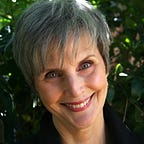Standing Firm
When Inaction is the Best Action
Taking steps is easy, standing still is hard.
So goes a portion of the lyrics of Regina Spektor’s haunting theme song “You’ve Got Time” from the Netflix original series, Orange is the New Black.
I’m not in prison, I’m in my weekly Iyengar yoga class. But this is the refrain drifting through my head as I strive to govern my attention, focusing it on my breathing, the balance of the weight in my feet, the alignment of my spine, the tilt — no, not a tilt, something else, is this it? — of my pelvis, the placement of my ribs and scapulae. The yoga instructor casts an appraising eye over my form and suggests changes.
“Draw your navel in strongly enough that you use that action to touch the tender place in your back,” he says, and I override my inner curmudgeon’s urge to offer a snarky comeback about the actual impossibility of such a thing. Because when I do what he suggests, I indeed find the crankiest region of my sacrum, and I find it with the interior of my core muscles. The motion is so subtle as to be, I’m sure, invisible to an observer, but the instructor nods and moves on. Meanwhile my abs and lower vertebrae say a cautious, respectful hello to one another, as they consider the merits of a partnership.
They haven’t been getting along lately. While happier than it when I first injured it, my lower back still mutters threats about what it can do to me should I fail to pay it careful attention or jerk it out of alignment with an ill-considered move. Like codependent relatives, other muscles in my mid back have rushed to mollify the disgruntled ones in my sacrum, trying to do their job for them, failing, and winding up in spasms of their own. Meanwhile my abdomen has struggled to find a balance between death-grip clenching and collapsing in defeat.
I’ve done what I can on my own, which is probably too much. I keep thinking I need more movement, which in a way is correct: remaining immobile for too long only promotes weakness, lethargy, and locked-up nerves and muscles. But flailing around with my arms and legs isn’t called for either, as frustrating as that is.
I worry about losing cardiovascular conditioning. I worry about missing my weight training sessions and my muscles turning to pudding. With my vanity still fully operational, I worry about the calories I’m not burning.
Yet here I am, standing still. And sweating. Executing tadasana, or Mountain Pose, with the careful precision demanded by Iyengar is humbling, and so much harder than it looks. Every single component of me is involved in the effort. By the time the teacher tells us to release the pose, my muscles are quivering.
I think of myself as being at an intermediate level in yoga, as in so much else in life. In my home practice and in other classes I like to flow in and out of the poses of which I’m capable, all the Warriors and Dancers and even a fledgling Crow here and there. That has its place. But in this class, you don’t move on until you’ve got your foundation exactly right, or as exactly right as your body can get it. Until you can stand still properly, all the fancy twisting and standing on one leg isn’t going to pass muster with your teacher.
I’m one of the few people I know who were sad when analogy questions were removed from the SAT exam. For me they had the addictive appeal that others attach to Sodoku or crossword puzzles. “Ambition is to achievement as _______ is to construction: (a) curiosity, (b) dry wall, © blueprint, (d) need. The fact that a reasonable argument could be advanced for more than one of those choices only adds to the attraction for me. One of those choices is the more apt, more precise, the better fit, the one that most reflects the relationship of the example.
So besides indulging my earworm, I found myself drawing analogies between Mountain Pose and, well, life.
Mountain Pose is to action as character is to behavior.
Mountain Pose is to communication as listening is to waiting (until the other person stops talking).
Mountain Pose is to exercise as depth is to a lake. Okay, that’s more like a metaphor, but you get my drift.
The truth of Regina Spektor’s lyrics reverberate through my frame, from my brain to my toes carefully spread on the mat. Standing still is indeed hard. With all the distressing news and disjointed cultural shifts and ever-more-shrill opinions washing over us like an endless chain of tsunamis, it’s easy to get swept away and flail helplessly in the noisy, surging confusion.
But then we’re just part of the flood. It might feel like we’re taking steps, as though we’re going somewhere, but in reality we’re flotsam and jetsam, bobbing along and adding our mass to the destruction.
Sometimes the most positive action we can take is to stand still. To remain firm amidst the tide. To stay rooted in truth that is timeless, bigger than ourselves, the foundation beneath the shifting currents.
Inaction is often assumed to be the shadow side of action. But like Mountain Pose, it can be surprisingly powerful.
And it’s harder than it looks.
Originally published at http://www.janmflynn.net on June 1, 2019.
